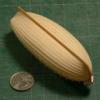-
Posts
13,302 -
Joined
-
Last visited
Content Type
Profiles
Forums
Gallery
Events
Everything posted by druxey
-
A rare manuscript memoir is coming to auction shortly. It's worth taking a look at it, although the estimate is beyond the pockets of most of us! See: https://www.sothebys.com/en/buy/auction/2019/english-literature-history-childrens-books-and-illustrations/william-owen-manuscript-memoir-in-india-and?locale=en
-
The taper of the wale and black strake into the stem rabbet is appreciated, Chuck. So few models have this right.
- 1,784 replies
-
- winchelsea
- Syren Ship Model Company
-
(and 1 more)
Tagged with:
-
Interesting. I was talking to a military re-enactor on Saturday and I asked why the army (circa 1812) did not use speaking trumpets. He replied that the fife had the best carrying power over distances and amid other sound.
-

Home made thicknessing sander if
druxey replied to Cabbie's topic in Modeling tools and Workshop Equipment
Please consider dust collection and control. Fine dust in the air is injurious to your health. Also, under certain conditions, a flash fire or explosion may occur. Sawmills have been destroyed and folk killed this way. -
Yes, thimbles of metal were used in the 18th century.
-
The last two photos of the double-double block (Canadians will get the reference!) appears to be a two-fold shoe block.
-
Yes, I'm familiar with those plans. They are 'generic', rather than those of a specific ship. All his models were to that scale. As a side comment, R.J. Collins was my first mentor way back when I was just a young kid. He was very encouraging and helpful to me, bless him.
-
Kurt: Thanks for your comments. I've also used Paasche, Iwata and Badger (all double action) over the years. All, I agree, perform really well, but occasionally I've messed up a needle tip when cleaning them. By comparison, the interchangeable tips for the Aztec are so easy to clean, which is the only reason I prefer it. As you say, each to their own!
-
Go to: https://collections.rmg.co.uk/collections.html#!csearch;searchTerm=50_gun_ship You'll find plenty of references!
-
Rees, Naval Archtecture, Plate VI, shows a small fore and aft bulkhead protruding from the beakhead bulkhead with a door on the aft side to allow a little more space within the head. Goodwin, The Sailing Man of War, page 182, shows the roundhouse without any door or enclosure inboard. It's just a small nook, really.
-
I agree with wefalck; those 'ship portraits' were probably idealized a bit - instead of PhotoShop they were ArtistShopped!
About us
Modelshipworld - Advancing Ship Modeling through Research
SSL Secured
Your security is important for us so this Website is SSL-Secured
NRG Mailing Address
Nautical Research Guild
237 South Lincoln Street
Westmont IL, 60559-1917
Model Ship World ® and the MSW logo are Registered Trademarks, and belong to the Nautical Research Guild (United States Patent and Trademark Office: No. 6,929,264 & No. 6,929,274, registered Dec. 20, 2022)
Helpful Links
About the NRG
If you enjoy building ship models that are historically accurate as well as beautiful, then The Nautical Research Guild (NRG) is just right for you.
The Guild is a non-profit educational organization whose mission is to “Advance Ship Modeling Through Research”. We provide support to our members in their efforts to raise the quality of their model ships.
The Nautical Research Guild has published our world-renowned quarterly magazine, The Nautical Research Journal, since 1955. The pages of the Journal are full of articles by accomplished ship modelers who show you how they create those exquisite details on their models, and by maritime historians who show you the correct details to build. The Journal is available in both print and digital editions. Go to the NRG web site (www.thenrg.org) to download a complimentary digital copy of the Journal. The NRG also publishes plan sets, books and compilations of back issues of the Journal and the former Ships in Scale and Model Ship Builder magazines.



